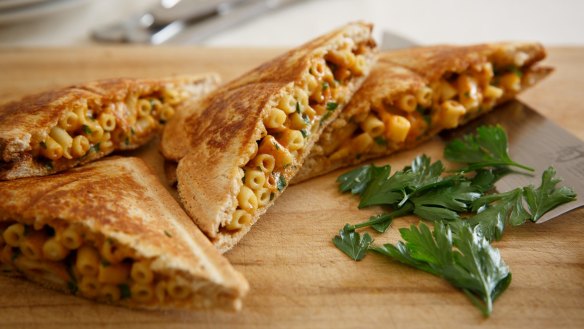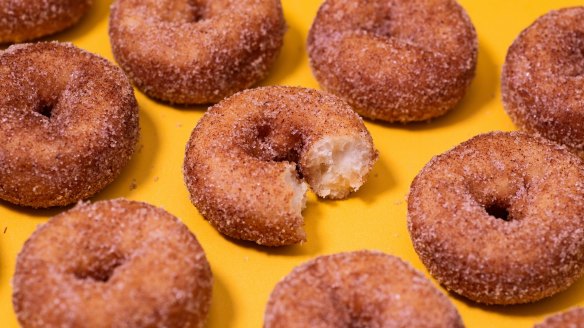Mac and cheese? Puh-lease! Adam Liaw on why we need to make Australian food great again

COMMENT
One thing you have to give the Americans credit for is the way they celebrate their food, even when it's not particularly good.
They'll take the most ordinary thing you could ever think to put in your mouth and worship it as if it were the bacon-wrapped second coming of Christ himself.
A Google search for "grilled cheese" returns 148 million results. "Mac n cheese" produces 212 million. The same search for "Vegemite sandwich" returns a paltry 587,000.
I grew up on American TV and comic books and I remember desperately wanting to try a Twinkie after seeing them in the pages of Archie comics. When I finally did try the little processed sponge cake at the age of 10 or 11 I was shocked that a food so impossibly … nothing … could be considered iconic.
At the same time I was discovering American childhood cuisine through comic books, I was eating the Australian equivalents – fairy bread, fish finger sandwiches, tinned spaghetti on toast, Deb mashed potato, tuna mornay and Viennetta. Pamela Clarke was making magic in the Women's Weekly Test Kitchen and Margaret Fulton was broadening Australian minds and palates.
No amount of marketing is going to replace the toasted marshmallows I had around family campfires with American s'mores.
These were the food icons of Australia through the 1980s when I grew up, and while they might not be the kinds of things we eat today, they were a product of their time and form a part of Australian food culture.
While we look at many of those foods with a kind of anachronistic pity, Americans are bringing the daggy foods of their childhoods into the 21st century. They've made a national pastime out of lionising – and modernising – underwhelming foods. And good on them.
A nation should be proud of its cuisine and shout it from the rooftops. What baffles me, however, is why we feel compelled to shout it for them, and at the expense of our own. Where's Australia's mac 'n' cheese?

Glazed American-style donuts can now be found in service stations and chain stores all over Australia, while the once ubiquitous and far superior Australian hot cinnamon doughnut has all but disappeared from the landscape.
Try and get a pancake in a cafe today and you won't find the thin, English-style ones most of us grew up on. They've been replaced by thick American-style stacks.
An Aussie pub slinging "barbecue" is more likely to be selling imitation Memphis-style ribs (often without a smoker) than a Bunnings-style snag in bread.
I'm not America-bashing here. I've spent a significant portion of my professional life there and am related to many very fine Americans in my immediate family whom I love dearly. They have some excellent food, too.
But no amount of marketing and brainwashing is going to make me cast my mind back to fond memories of mac 'n' cheese I never ate, or replace the toasted marshmallows I had around family campfires with American s'mores I didn't.
Yet we are expected to – and often do – fawn over the pretend nostalgia of a childhood we only saw on TV.
It's inevitable that our food and food culture changes. Before Australian food was Americanised, it was Thai-ified, Vietnam-ised, Mediterranean-ed, Lebanese-d, Chinese-ified and colonised. The difference is when we started eating laksa we never pretended we grew up on the stuff.
My complaint isn't just about decrying new influence in our cuisine, it's about failing to acknowledge that our cuisine has merit itself.
Cultural cringe has been a defining aspect of the Australian psyche for more than 100 years. Henry Lawson wrote about it back in the 19th century, and the term itself was coined by Melbourne critic AA Phillips in 1950, who bemoaned that Australian arts only saw their value if recognised in England or America, rather than being appreciated in Australia.
That same cultural cringe is a weight around the neck of modern Australian food culture.
Food doesn't need to be complicated or sophisticated to be good, and if we look down on our own cuisine we run the risk of losing it to antiquity.
The American mac 'n' cheese of 2021 is very different to what it was in 1980. Australian restaurants put their spin on it more than they do tinned spaghetti on toast, or Continental Alfredo Pasta & Sauce. But if Australian food culture is to grow, our iconic foods need to be brought into the modern day.
In some cases they are. Jaffles have been having a moment for the past few years (although when I was a kid we called them "toastie toasties" for some ludicrous reason), and while we still approach them with some nostalgia, they are now a part of modern Australian food culture as well as its past.
Today's kids won't grow up not knowing what a jaffle is, and perhaps in time they'll become as iconic to Australian food as mac 'n' cheese is to America.
I love all the global influences that have come to our cuisine, but in order for local food culture to grow, we need to give Australian cooking a little overdue respect.
Appears in these collections
- More:
- Food
